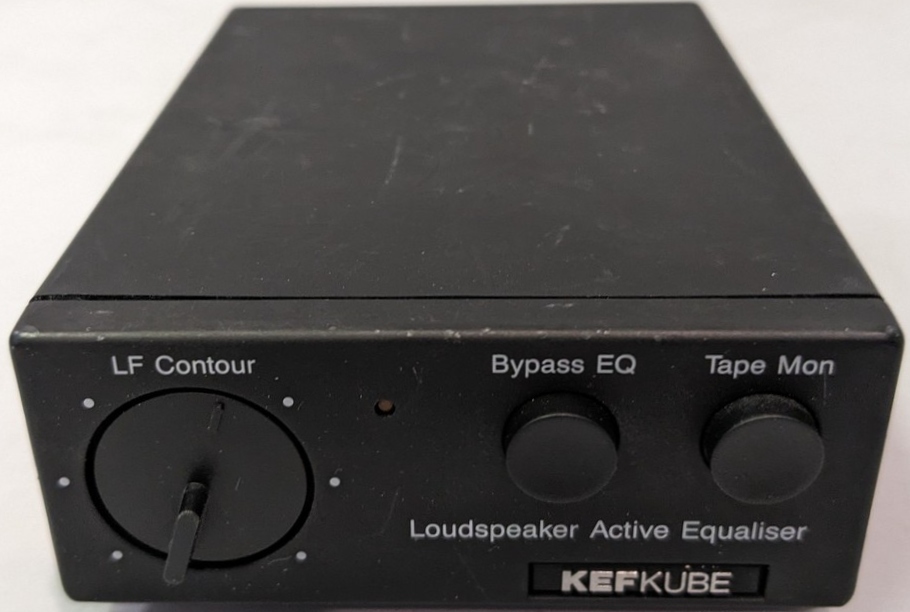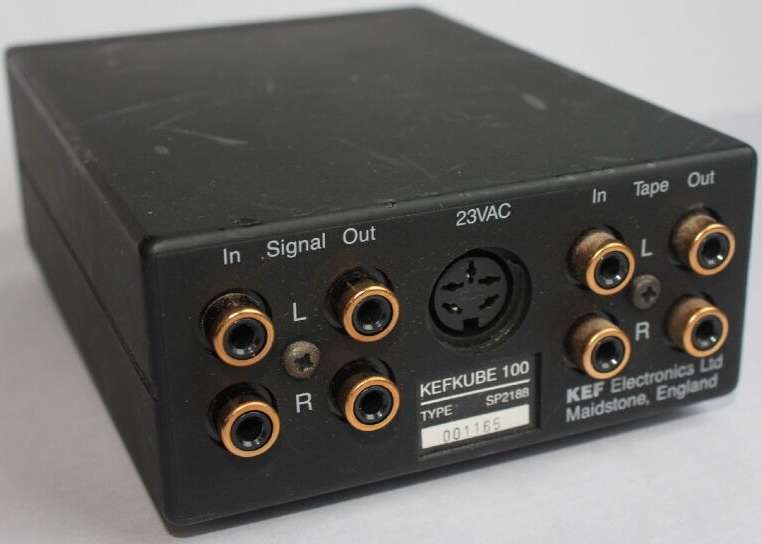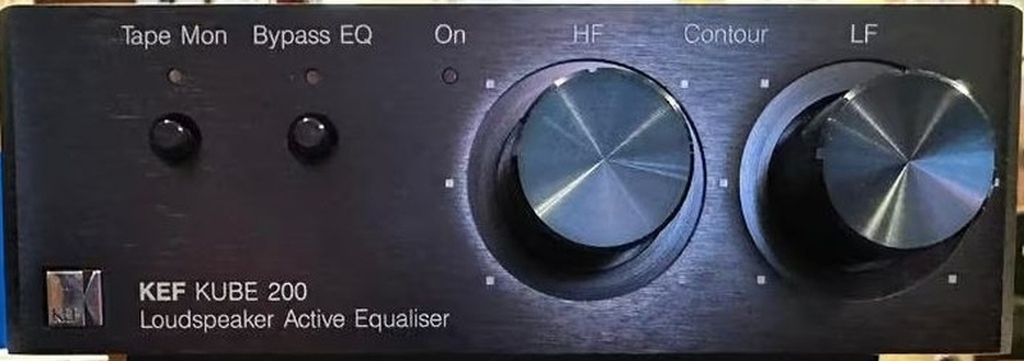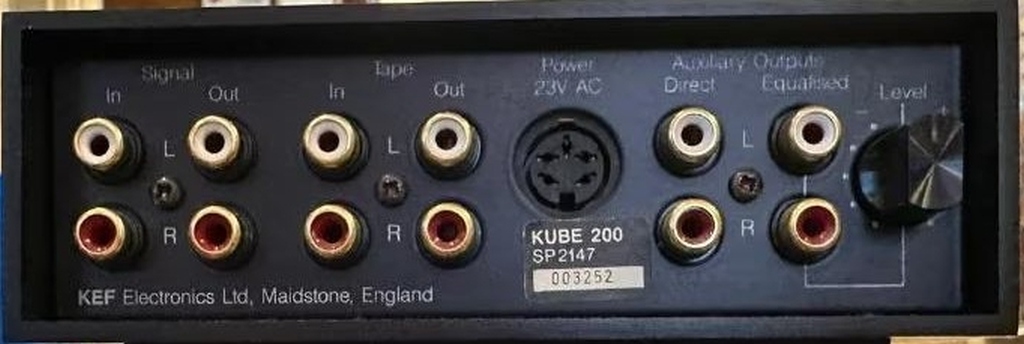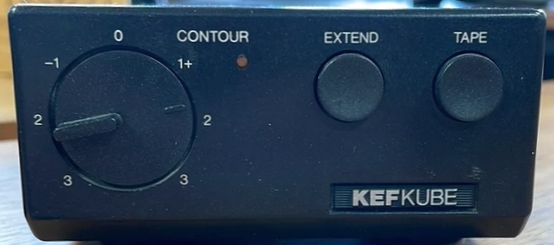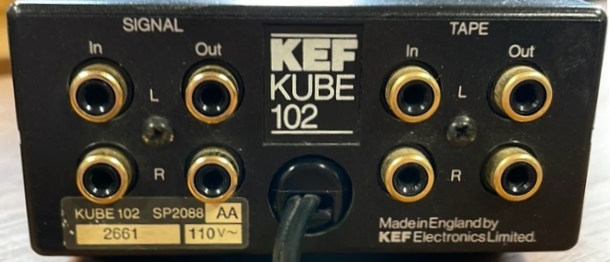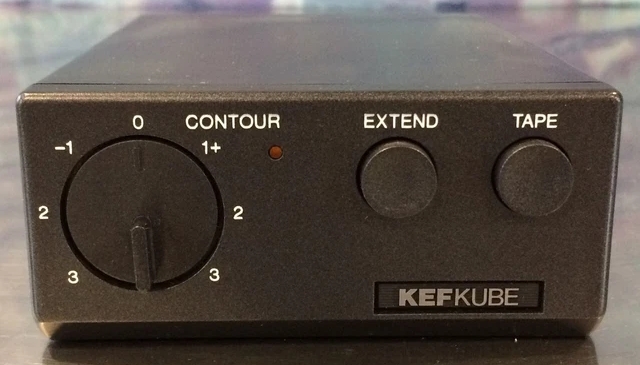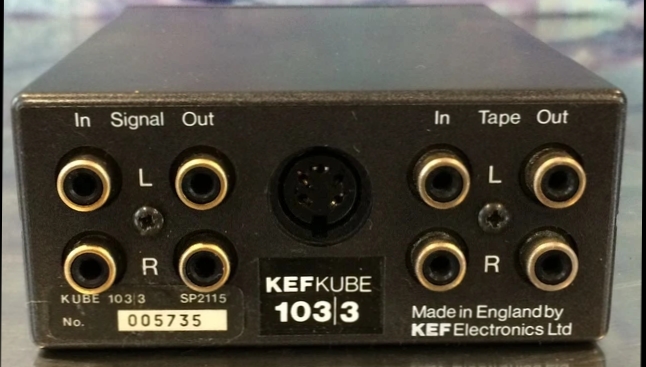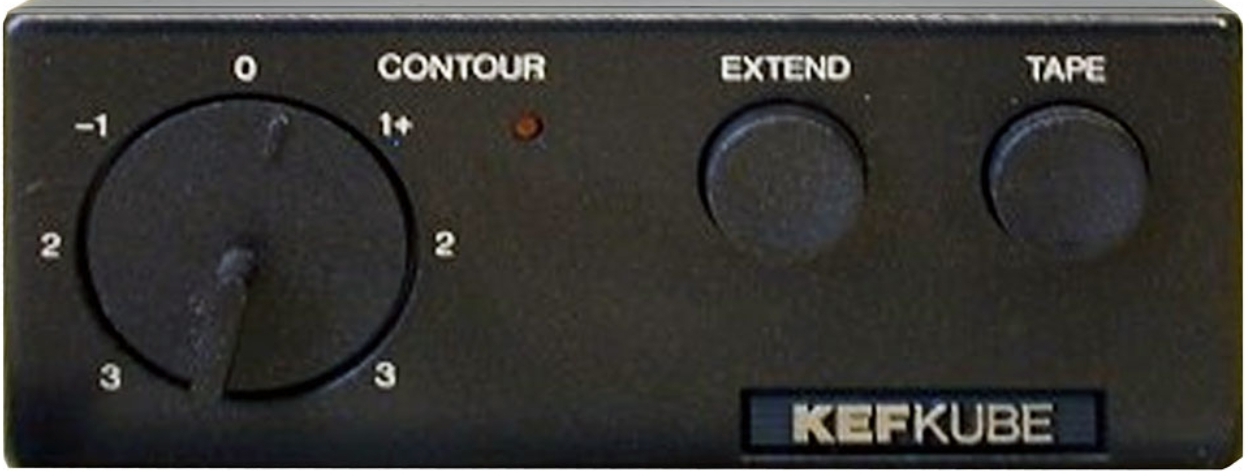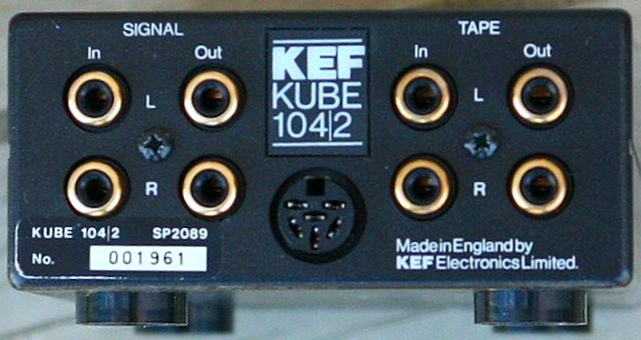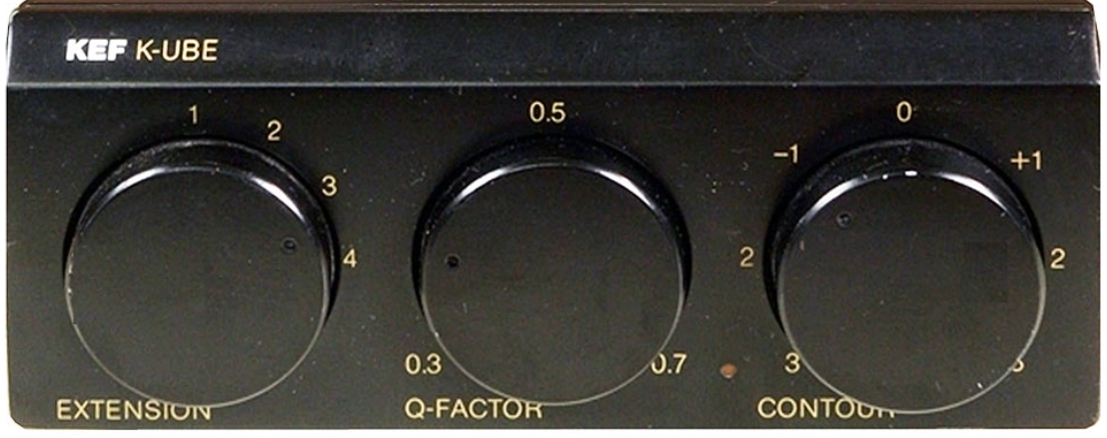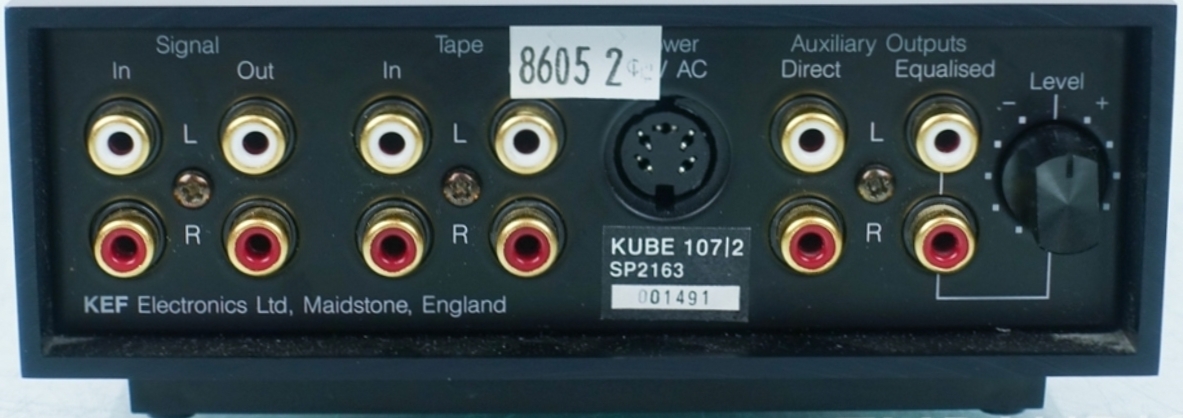KEF Universal Bass Equalizer
Door Kef omgeven met veel mooie woorden, maar het is gewoon een toonregeling die bekendheid kreeg door het gebied tussen 20 Hz en 160 Hz
een paar dB op te krikken. Er zijn uiteraard voorstanders, maar ook critici die zeggen dat het hoorbaar tegenvalt.
AvO Heb het altijd overdreven gevonden. Ik denk dat Raymond Cooke - die ik vaak heb ontmoet - met die K-Ube wilde voorkomen dat het ontwerp van zijn luidsprekers werd aangepast aan de heersende smaak van dreunend en overdreven laag. Dan kon je kiezen en bleef het ontwerp gaaf.
De Kube 100 Loudspeaker Active Equalizer (SP2188).
| Description | Active equaliser providing fixed and variable equalisation |
| Controls LF Contour | Continuously variable shelf control allowing boost or attenuation over the range +3 to -3 dB. Shelf centre frequency 160 Hz. |
| Controls Tape Monitor | Push button controls the tape input/output via rear sockets |
| Controls Bypass EQ | Push button to bypass fixed and variable equalisation |
| Rear Panel Connections | All signals input and output via gold platet phono (RCA) sockets |
| Input Impedance | 51 k Ohm |
| Maximun Input Voltage | >2 V rms above 20 Hz >8 V above 50 Hz |
| Maximum Output Voltage | >5 V rms |
| Ouput Impedance | 470 Ohm |
| Ouput Noise Level | <3 uV A-weighted |
| Signal-to-Noise Ratio | >110 dBA ref 1 V rms |
| Distorsion | <0.005 % for 1 V rms input @ 1 kHz |
| Power Supply | 23 V AV @ 0.3 A from factory supplied power unit: SP2185 for 100 V, 50 Hz SP2184 for 120 V, 60 Hz SP2186 for 220 V, 50 Hz SP8127 for 240 V, 60 Hz |
| Weight | 1.0 kg, 2.2 lb |
| Dimensions | 52(h) x 100(w) x 140(d) mm 2(h) x 3.9(w) x 5.5 (d) in |
KEF Kube 200 Loudspeaker Active Equalizer (SP2147).
Handleiding van de Kube 200: "The KUBE 200 is an active low-level equalizer designed exclusively for use with specific KEF Reference Series loudspeakers.
De Kube 200 heeft een vaste laagcorrectie, maar daarnaast ook twee variabele 'Contour'-correcties, in wezen gewoon een toonregeling. De LF-(Low Frequency)-contour werkt onder de 160 Hz, de HF-(High Frequency)-contour werkt boven de 1 kHz. Verder zit er een 'Bypass'-functie op die zowel de vaste laag-correctie als de LF- en HF-contour uitschakelt, dus je kunt snel vergelijken wat de laagcorrectie doet.
| Description | Active equaliser providing fixed and variable equalisation |
| LF Contour | Continuously variable shelf control allowing boost or attenuation over the range +4 to -6 dB. Shelf center frequency 160 Hz. |
| HF Contour | Continuously variable shelf control allowing boost or attenuation over the range +4 to -6 dB. Shelf center frequency 1 kHz. |
| Tape Monitor | Push button to controls tape input/output via rear sockets. |
| Bypass EQ | Push button to bypasses fixed and variable equalization. |
| Rear Panel Connections | All signal inputs and outputs via gold plated phono (RCA) sockets power in (low voltage AC) via 5-pin DIN connector. |
| Input Impedance | 51 k ohms. |
| Maximum Input Voltage | >1.9 V rms above 20 Hz. >8 V rms above 50 Hz. |
| >5 V rms. | |
| Output Impedance | 100 ohms. |
| Output Noise Level | <6 uV A-weighted |
| Signal-to-Noise Ratio | >104 dBA ref 1 V rms. |
| Distortion | <0.005 % for 1 V rms input @ 1 kHz. |
| Power Supply | 23 V AC @ 0.3 A from factory supplied power unit: Suitable adaptors are for 120 V, 60 Hz; 220 V, 50 Hz; or 240 V, 50 Hz. |
| Weight | 1.30 kg, 2.87 lb. |
| Dimension | 65(h) x 152(w) x 234(d) mm 2.6(h) x 6.5(w) x 9.2(d) in. |
|
Mijn mening over de Kef Kube zijn de meningen verdeeld, zie de twee alinea's bovenaan deze pagina. Maar deze Kube 200 'kwam langs' voor een heel schappelijk bedrag en dan kruipt het bloed waar ... Hij (m/v/x) is geschakeld tussen een Quad 34 (revisie AvO) en een Quad 303 (revisie AvO) en speelt op een set Kef 103/4 (revisie Audiolab). Beluisterde muziek is van Abba t/m Zappa, van Bach t/m Saint-Saëns. Audiospelers: internetradio, minidisc (wav en flac) en een digital audio player (wav en flac). En hoe klinkt het? Beter geformuleerd: maakt de Kube zijn belofte waar (het gebied tussen 20 Hz en 160 Hz een paar dB opkrikken)?
De Kube is nu een paar weken in gebruik en ik verbeeld me dat ik nu wel een mening mag opschrijven.
Samenvatting: het geen ei-van-columbus, geen wonder uitvinding, geen must-have. een purist zal zijn neus er voor ophalen. De Kube blijft nog wel even, al is het alleen maar omdat er zelden eentje wordt aangeboden en je er dus nogal wat moeite en tijd moet insteken om er eentje te bemachtigen (datzelfde argumernt kan worden gebruikt om 'm snel weer te verkopen...). |
Er zijn ook Kube's speciaal voor een bepaald luidsprekermodel.
Maar sommigen daarvan lijken verdacht veel op elkaar.
Bron: AI.
The KUBE (KEF Universal Bass Equalizer) was a separate, active bass equalization component from the 1980s designed to extend the bass response and improve performance of KEF loudspeakers, particularly the Reference Series. It allowed users to adjust parameters like the bass cutoff frequency and the 'Q' of the bass response, tailoring the sound to their specific room and personal preferences. While the KUBE is a vintage component, KEF continues to incorporate advanced bass management and equalization technologies, such as the Music Integrity Engine® in their modern Kube subwoofers, to achieve enhanced bass performance and effortless immersion.
- Extended Bass: It allowed compact KEF speakers to achieve extended low-frequency responses, with some systems reaching down to 20Hz.
- User-Adjustable EQ: The KUBE provided control over the bass cutoff frequency and the 'Q' factor, which affects the sharpness of the bass resonance and the damping of bass transients.
- Room Adaptation: It offered a way to tailor the speaker's bass output to suit different room acoustics and listener tastes.
- Integral Part of the System: For some KEF systems, like the Model 107, the KUBE was considered an essential and integral part of the system to achieve the specified performance.
- The KUBE was a solid-state, active component that was connected in the tape monitor loop of an amplifier, or between the preamplifier and power amplifier sections.
- It contained a speaker-specific equalization module for the mid/treble drivers and an inverse of the loudspeaker's low-frequency response to complement the bass enclosure.
- While the original KUBE is a vintage component, KEF's philosophy of achieving extended and controlled bass continues in their modern product lines, such as their Kube subwoofers.
- These modern subwoofers feature the Music Integrity Engine®, an advanced digital signal processor (DSP) that optimizes bass performance for a more immersive experience.
| Colofon Disclaimer Privacy Zoeken Copyright © 2002- G. Speek |
